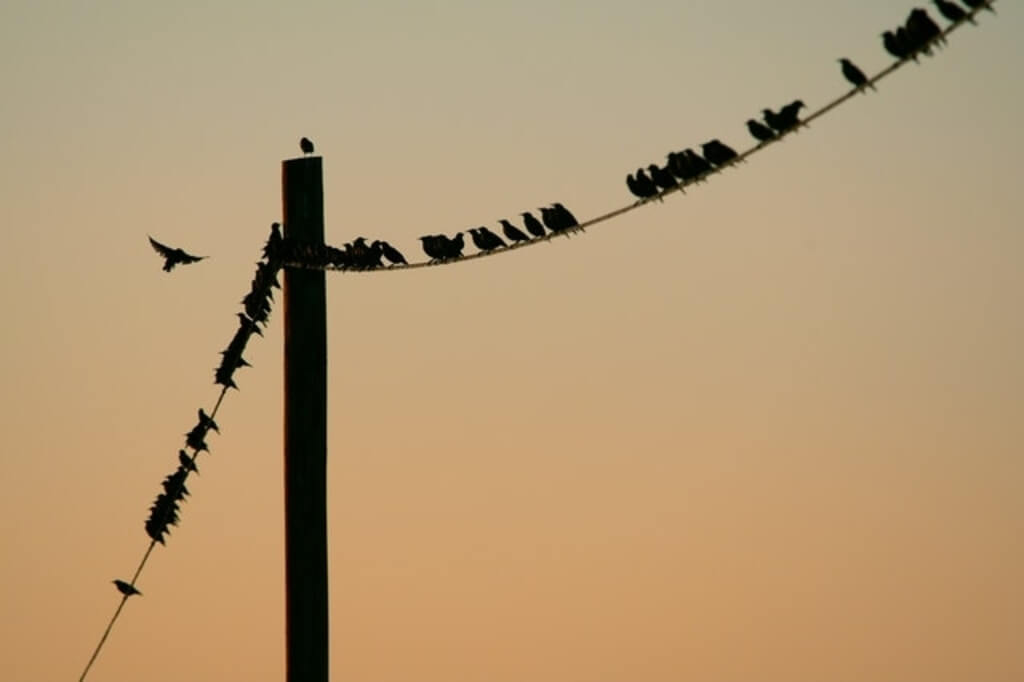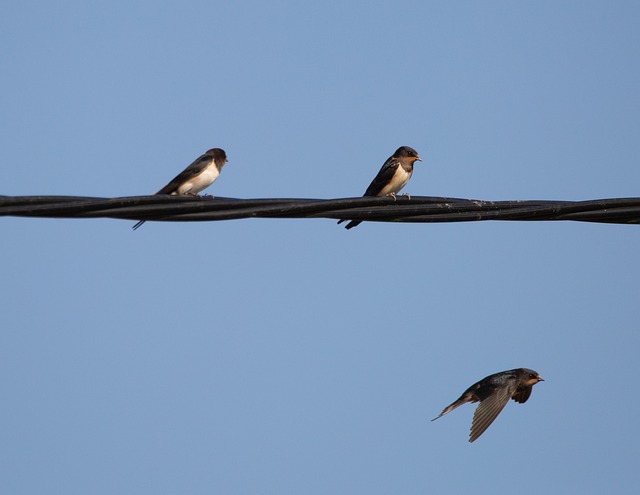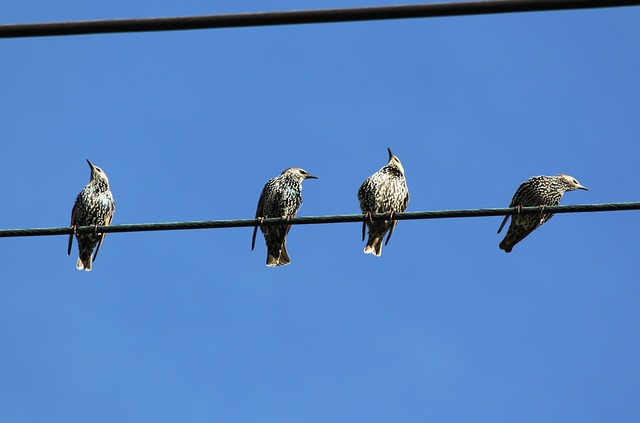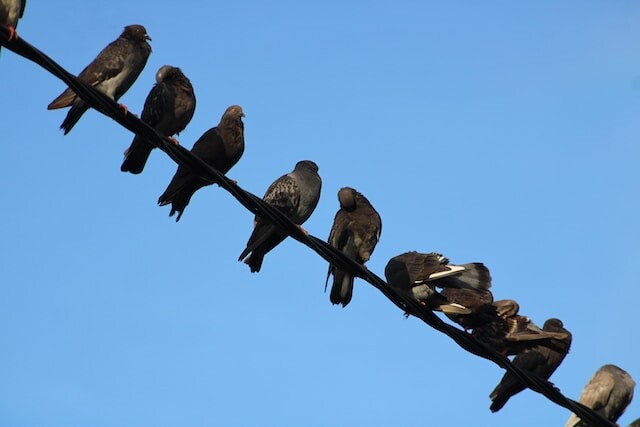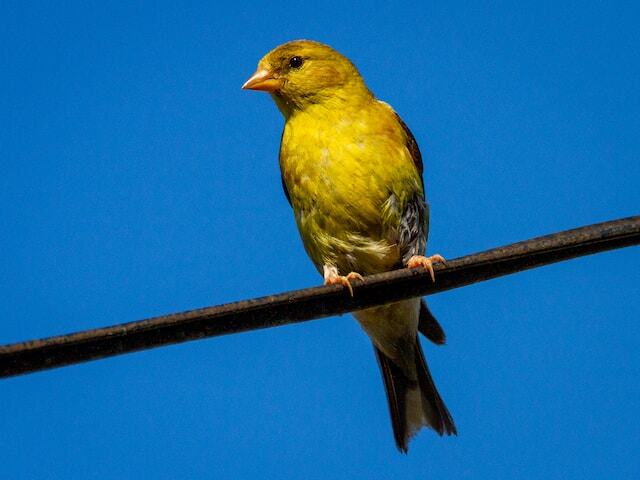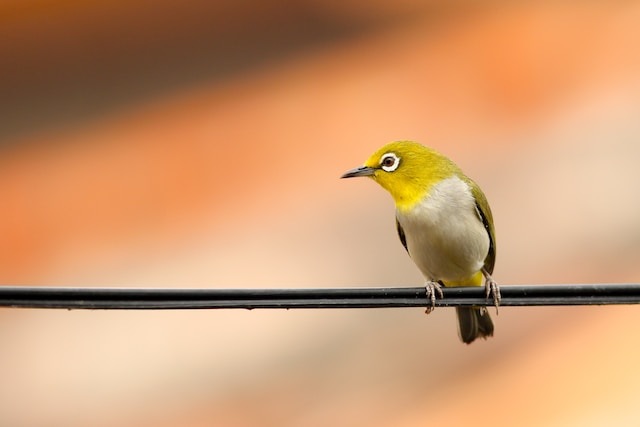Have you ever gazed up at a stretch of power lines, only to find them dotted with perched birds? In this exploration, we take a look into the intriguing phenomenon: why do birds sit on power lines? Uncover the avian insights behind this behavior and gain a deeper understanding of our feathered neighbors.
Table of Contents
- 1 Key Takeaways:
- 2 Why Do Birds Sit On Power Lines?
- 3 The Appeal of Power Lines for Birds
- 4 Safety Considerations for Birds on Power Lines
- 5 Bird Nesting on Power Lines
- 6 Bird Behavior and Communication on Power Lines
- 7 Birdwatching Opportunities on Power Lines
- 8 Impact of Power Lines on Bird Populations
- 9 Conservation and Mitigation Efforts
- 10 The Future of Birds and Power Lines
- 11 Decoding Birds on Power Lines: A Balancing Act
- 12 FAQs
- 12.1 Are there any adaptations that allow birds to balance on power lines?
- 12.2 How are birds protected from electrocution on power lines?
- 12.3 Why do some bird species choose to nest on power lines?
- 12.4 How do birds communicate on power lines?
- 12.5 Can power lines impact bird populations?
- 12.6 What conservation measures are being taken to protect birds on power lines?
- 12.7 What does the future hold for birds and power lines?
- 12.8 What is the significance of understanding and protecting bird behavior on power lines?
- 13 Author
Key Takeaways:
- Birds perch on power lines for a variety of reasons, including safety, visibility, and other advantages offered by the structure and height of power lines.
- Despite the potential hazards associated with power lines, many bird species have adapted to safely balance on the electrical wires.
- Power lines offer unique nesting opportunities for some bird species, and they are also used for communication and social interactions between birds.
- It is important to understand the potential impact of power lines on bird populations and to take measures to mitigate any negative effects.
- Ongoing research and technological advancements will help us better understand and protect bird behavior on power lines in the future.
Why Do Birds Sit On Power Lines?
Birds choose to perch on power lines for several reasons. Power lines provide a vantage point that allows birds to scan the surrounding area for prey or predators. The height and structure of power lines also offer a safe and stable platform for birds to rest and groom. Additionally, power lines may provide warmth to birds during colder weather.
The Appeal of Power Lines for Birds
Why do birds perch on power lines? The answer lies in the numerous advantages that power lines offer to our feathered friends. Here are the top reasons birds choose to perch on electrical wires:
- Height and vantage point: Power lines are often elevated, providing birds with a bird’s-eye view of their surroundings. From this high perch, birds can easily spot prey, predators, and potential mates.
- Safety: Unlike tree branches that can sway in the wind, power lines are stable structures that can withstand a range of weather conditions. Additionally, due to the conductive properties of metal, power lines are less likely to attract lightning strikes than trees.
- Easy takeoff and landing: The smooth, narrow surface of power lines provides optimal conditions for birds to take off and land with ease.
- Escape routes: In the event of danger, birds can quickly take flight from power lines and escape to a safer location.
- Warmth: During the colder months, power lines serve as heat conductors, providing birds with a source of warmth.
Birds have also evolved specialized adaptations that enable them to safely perch on power lines without getting electrocuted. Their unique physiology and behavior allow them to balance on the wires, while avoiding contact with other wires or the ground.
The Appeal of Power Lines for Birds.
“Power lines provide birds with a high, stable, and safe vantage point, perfect for spotting prey, predators, and potential mates. Additionally, the smooth surface of power lines provides the ideal conditions for easy takeoff and landing.”
As we can see, power lines are much more than just a functional infrastructure. They offer a unique habitat for birds, providing numerous advantages and opportunities for survival. Understanding the appeal of power lines for birds is crucial for bird conservation and ensuring our coexistence with these fascinating creatures.
Safety Considerations for Birds on Power Lines
Birds have adapted to perch on power lines safely, as they have developed specialized mechanisms to avoid electrocution. The electrical current flowing through the wires does not harm them, as birds have an insulation mechanism that prevents the electricity from passing through their bodies.
However, birds can get electrocuted if they come in contact with other components of the infrastructure or if they touch multiple wires at once. In addition, power lines can be hazardous for birds in adverse weather conditions, such as storms and heavy rain, as wet feathers can conduct electricity more easily, increasing the risk of electrocution.
To protect birds from electrocution and other hazards associated with power lines, many measures have been taken. Various organizations have developed bird protection guidelines, such as insulating wires and creating alternative habitats to minimize potential harm to birds. Moreover, utility companies have installed special equipment to prevent birds from landing on dangerous parts of the infrastructure and have also conducted regular inspections to ensure the safety of the birds.
In conclusion, while power lines are safe perching spots for birds, they can be hazardous in certain situations. It is essential to take measures to protect birds from electrocution and ensure their safety. By understanding avian behavior on power lines and implementing appropriate conservation efforts, we can create a harmonious coexistence between birds and humans.
Bird Nesting on Power Lines
Power lines provide a unique nesting opportunity for some bird species. These birds typically create their nests by weaving sticks and other materials around the power lines. This behavior is known as power line or pole-top nesting.
There are several reasons why birds choose power lines as nesting sites. The height of power lines provides a sense of security and protection from predators. Additionally, the open space around power lines allows for better visibility and easier access to food sources.
However, power line nesting can also present challenges for birds. The heat generated by electrical currents can cause damage to eggs and nestlings. There is also a risk of electrocution if the nest is not properly built or if a bird comes into contact with a nearby conductor.
Safety measures have been put in place to protect birds nesting on power lines. These include insulating wires, modifying structures, and creating alternative nesting habitats. These efforts have been successful in reducing the number of incidents and ensuring the safety of bird populations.
Power Line Nesting Species
Several bird species are known to engage in power line nesting. Some of the most common species include:
- American Kestrels
- Ospreys
- Hawks
- Eagles
- Pigeons
Power line nesting can provide excellent opportunities for birdwatching and research. It allows for close observation of nesting behavior and provides insight into the adaptation of birds to human-altered environments.
Overall, power line nesting is a unique behavior that showcases the adaptability of birds. While it presents challenges and risks, efforts are being made to protect bird populations and ensure their coexistence with human infrastructure.
Bird Behavior and Communication on Power Lines
Power lines not only offer birds a safe and elevated resting spot, but also serve as a social hub for various communicative behaviors. Bird behavior on power lines is an excellent way to observe social interactions, such as courtship displays or territorial disputes, between different bird species.
Birds have adapted to balance on narrow power lines, exhibiting impressive agility and balance to maintain their position without falling. Their talons provide a sturdy grip on the wires, while their wings act as a counterbalance to help them maintain stability.
Interestingly, scientists have found that some bird species display a preference for certain wires on power lines, indicating a high level of social complexity and organization among avian populations.
Birds also use power lines for communication, such as singing and calling to one another. Studies have shown that birds tend to congregate on power lines during dawn and dusk, which correlates with peak singing times for many bird species.
Bird Balance and Communication on Power Lines
The ability of birds to balance and communicate on power lines is a testament to their unique adaptations to their environment. These social hubs provide a wealth of opportunity for birdwatchers to observe avian behavior and interactions in a natural setting.
Birdwatching Opportunities on Power Lines
Observing birds perching on electrical wires can provide excellent birdwatching opportunities. Power lines offer a unique habitat for birds to display their behaviors and social interactions.
One of the advantages of birdwatching on power lines is that they provide a clear vantage point for bird watchers. Birds perching on power lines are easily visible, making it convenient for birdwatchers to identify and observe them. Additionally, the height of the power lines provides a better view of the surrounding landscape, allowing birdwatchers to spot other birds flying overhead.
Various bird species can be observed sitting on electrical wires, including finches, sparrows, doves, and sometimes even raptors. Different species exhibit different behaviors, making each viewing experience unique and exciting. For example, some birds may display mating rituals or courtship behaviors while others may engage in territorial displays or vocalizations.
However, it is important to remember that birdwatchers should observe birds from a distance to avoid disturbing them. Excessive noise or sudden movements could scare the birds and ruin the birdwatching experience for others.
Tips for Birdwatching on Power Lines
- Carry binoculars to observe birds in detail.
- Stay quiet and avoid sudden movements.
- Respect the birds’ space and avoid getting too close.
- Try birdwatching during the early morning or late afternoon when many birds are active.
By observing birds on power lines, we can gain a better understanding of their behavior and the important role they play in our ecosystem. So next time you spot a bird perching on an electrical wire, take a moment to appreciate their beauty and watch their behavior in action.
Impact of Power Lines on Bird Populations
While power lines offer several benefits to birds, they also pose significant risks to their safety. Birds can be electrocuted when they come into contact with power lines, resulting in injury or death. The constant humming of the electrical wires can also interfere with bird communication, potentially disrupting breeding behaviors and social interactions.
To address these concerns, conservation efforts have been implemented to protect bird populations living near power lines. Power companies have taken measures such as insulating wires, modifying structures, and creating alternative habitats to minimize harm to birds. Some companies have even created special nesting platforms for birds to encourage safe nesting and breeding behaviors.
Bird protection on power lines is also being addressed through innovative technologies such as bird diverters that decrease the risk of electrocution. These devices are designed to make the power lines more visible to birds, encouraging them to avoid direct contact. Such measures can significantly reduce the number of bird fatalities associated with power lines.
Despite these efforts, however, power lines continue to pose a threat to bird populations. Studies have shown that bird populations living near power lines may experience lower reproductive success and lower population densities. It is crucial for power companies and conservationists to work together to address these concerns and ensure the preservation of bird populations in the future.
Conservation and Mitigation Efforts
Bird protection on power lines is crucial for the conservation of these remarkable creatures. Although power lines can be a great habitat for birds, they also pose risks. Electrocution, collisions, and habitat loss are some of the hazards that birds face when perching on electrical wires. In recent years, efforts have been made to mitigate these risks and reduce the impact of power lines on bird populations.
One of the strategies used to protect birds from electrocution is to insulate the wires. This is particularly important for birds that frequent high-voltage power lines, such as raptors and other large birds. Insulating wires can reduce the risk of lethal electrocution, making power lines safer for birds to perch on.
Another method to protect birds is to modify the structures that support the power lines. For example, installing bird flight diverters on power lines can help prevent collisions by increasing the visibility of the wires. These devices are especially useful for preventing large birds, such as eagles and vultures, from colliding with the wires.
Creating alternative habitats for birds is also a key conservation strategy. By providing suitable nesting sites and feeding areas, alternative habitats can reduce the dependence of birds on power lines. This can be achieved through the planting of trees, the creation of wetlands, and the installation of nest boxes.
Overall, it is critical to balance the benefits of power lines for birds with their potential risks. By implementing conservation and mitigation efforts, we can ensure the coexistence of birds and humans in power line habitats.
The Future of Birds and Power Lines
As our society continues to rely on electricity and power line infrastructure, it is essential to consider the impact on bird populations. The nesting behavior of birds on power lines is a unique phenomenon that requires careful attention to ensure their safety and preservation.
Researchers and experts are constantly studying the effects of power lines on bird behavior and populations. Ongoing studies are exploring new technologies and solutions to mitigate any negative impacts, such as insulating wires, reducing the number of structures and lines, and creating alternative habitats for birds.
Conservation efforts are also underway to protect birds nesting on power lines, including modifying structures and implementing safety measures to prevent electrocution. Many utility companies are committed to protecting birds on their power lines and have joined partnerships with conservation organizations to develop best practices and guidelines.
While power line infrastructure will continue to expand, it is crucial to balance the needs of birds and humans. By understanding the behavior of birds on power lines and implementing conservation and mitigation efforts, we can ensure the coexistence of these remarkable creatures and preserve their critical role in our ecosystem.
Decoding Birds on Power Lines: A Balancing Act
Throughout this article, we have explored the fascinating behavior of birds choosing to perch on power lines. The various factors that make power lines attractive to birds include height, structure, and safety. Birds have adapted to balance on the electrical wires safely and use power lines for nesting, communication, and social interactions.
The Importance of Bird Conservation
Understanding and protecting this behavior is crucial for bird conservation and our coexistence with these remarkable creatures. We must acknowledge the potential impact of power lines on bird populations, such as affecting migration patterns and nesting success. Conservation efforts, including modifying structures and creating alternative habitats, can help mitigate any negative effects and preserve bird populations.
The Future of Birds and Power Lines
The ongoing research and technological advancements can provide more sustainable solutions for power line infrastructure that balances the needs of birds and humans. In the future, we must continue to prioritize bird protection and work towards innovations that minimize the potential harm of power lines on bird populations.
In conclusion, we have uncovered the intriguing reasons behind why birds choose to perch on power lines. Power lines offer unique opportunities for birds, and it’s fascinating to see how they have adapted to thrive in this habitat. As we continue to learn and explore, let us also prioritize the conservation and protection of these remarkable creatures.
FAQs
Are there any adaptations that allow birds to balance on power lines?
Yes, birds have developed adaptations that enable them to balance on power lines. Their feet and legs have specialized tendons and muscles that allow them to tightly grip the wires. Additionally, birds have a flexible ankle joint that helps them maintain stability while perching on the thin electrical wires.
How are birds protected from electrocution on power lines?
Measures have been taken to protect birds from electrocution on power lines. Insulators are used to prevent electrical current from flowing through the wires and harming birds. Additionally, bird diverters, such as reflective devices or markers, are often installed on power lines to increase their visibility and reduce the risk of collisions.
Why do some bird species choose to nest on power lines?
Power lines can provide advantageous nesting sites for some bird species. The elevated position of power lines offers protection from ground predators, and the open structure allows for easy access to the nest. The warmth generated by the electrical current may also be beneficial for incubating eggs or keeping nestlings warm.
How do birds communicate on power lines?
Power lines serve as perching areas for birds to engage in various social behaviors and communication. They use vocalizations, body postures, and visual displays to communicate with other birds. Power lines provide a central meeting point for social interactions, courtship displays, and territorial disputes among birds.
Can power lines impact bird populations?
Power lines can have potential impacts on bird populations. Their presence may disrupt natural migration patterns and create barriers to movement for some bird species. Nesting on power lines can also pose risks, as birds may be exposed to disturbance or hazards from maintenance activities. However, with proper mitigation efforts, these impacts can be minimized.
What conservation measures are being taken to protect birds on power lines?
Conservation efforts to protect birds on power lines include insulating wires to prevent electrocution, modifying structures to minimize nest disturbance, and creating alternative habitats for birds. Additionally, research and monitoring programs are ongoing to better understand the interactions between birds and power line infrastructure.
What does the future hold for birds and power lines?
The future of birds and power lines involves ongoing research and technological advancements to find innovative solutions that balance the needs of birds and humans. It is important to continue striving for sustainable power line infrastructure that minimizes negative impacts on bird populations and ensures their conservation for future generations.
What is the significance of understanding and protecting bird behavior on power lines?
Understanding and protecting bird behavior on power lines is crucial for bird conservation efforts. Power lines provide important habitat and social interaction opportunities for birds. By safeguarding their safety and minimizing disturbances, we can promote the coexistence of birds and humans while ensuring the preservation of avian biodiversity.

